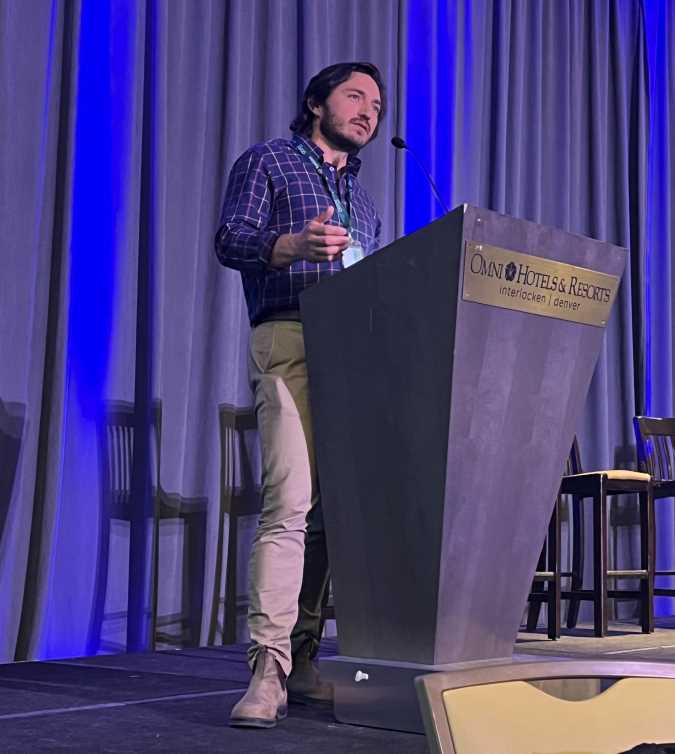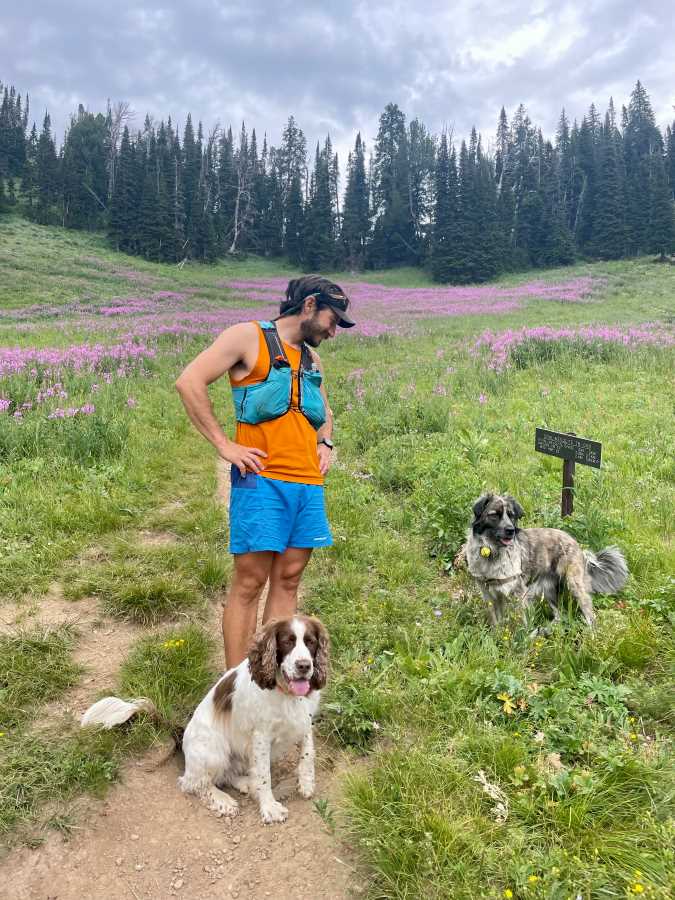Juan Gallego-Calderon, an engineer at Idaho National Laboratory, discusses how his education and work with other energy technologies led him to exploring how hydropower can play a more active role in the electricity grid.
Water Power Technologies Office
December 10, 2024
In March 2024, Juan Felipe Gallego-Calderon eloped. But he and his fiancé didn’t duck into a dusty quick-hitch chapel in Las Vegas. First, they hiked to a mountain summit, where they changed into traditional wedding outfits—a floor-length white gown and a black suit. One of two friends married them; the other snapped photos. Then, after some celebratory charcuterie and champagne, the couple strapped on skis and backpacking gear and headed into the snowy slopes of Idaho’s Teton Pass, their two dogs running alongside.
Gallego-Calderon’s mountain wedding was surprising—but not only because most people opt for stationary, snow-free ceremonies. When Gallego-Calderon was a kid growing up in Colombia, being outside typically meant playing sports in fenced-in city fields or, occasionally, chasing chickens and climbing guava, mango, or lemon trees at one of his grandparents’ houses in the mountains.
“I never in my life thought that I would be where I am now,” Gallego-Calderon said. “I used to love watching videos of people skiing or doing all this outdoor stuff. And I was like, ‘Oh man, only pros can do that.’”
Now, Gallego-Calderon has skied around the world and built a career focused on protecting his precious, vast, natural playgrounds. As an engineer at Idaho National Laboratory, Gallego-Calderon analyzes how the country could get more energy from renewable sources. Right now, he’s focusing on hydropower—specifically how this affordable, reliable source of renewable energy could be paired up with solar panels (floating on reservoirs, for example) or generated using existing infrastructure—like dams that aren’t outfitted to generate hydropower.
“Whatever I can do to solve this big problem—climate change—is good for me,” Gallego-Calderon said. “That will be my purpose.”
In this Q&A, Gallego-Calderon shared what it was like to come to the United States with just $800 in his pocket and how he’s helping get more hydropower onto the grid.
-

How did you originally find your way into science?
I was lucky. In Colombia, the public system is not as reliable, so going to private school is very common. I attended a Catholic school heavily focused on math and science. Like every other kid, I wanted to be a marine biologist, but in Colombia, that wasn’t a sustainable career. Engineering seemed like a good choice.
Did you know early on that you wanted your work to have an environmental component?
Oh yeah. As a kid, I always appreciated nature. And in school, some of us got a little badge, and if we saw people being wasteful, we’d say something. I remember there was someone cleaning with a hose that didn't have a spout; it was spilling water everywhere, and I told her, ‘You shouldn’t do that.’ It always seemed natural that we should protect nature even though my parents were low to middle class and just trying to survive. When you have that scarcity mentality, environmental causes are secondary.
Why did you come to the United States?
I came to California for my master’s in electrical engineering at Fresno State University, and I was very fortunate that I had a place to land. I came here with 800 bucks, but I had some family there, and my uncle—Alejandro Calderon-Urrea—and his family helped me. He’s a professor at the university, and he always told me, ‘Education is very important. You’re smart enough. You can do it.’
I crashed with him, but after the first semester, I was on my own. As an international student, that was very tough. The tuition was high. I was working part time to earn living expenses. But once I moved out of Colombia, my life was pretty easy compared to when I was there.

What made you shift your attention to renewable energy, specifically?
It was during my master’s that I got interested in renewables. I started working with the Center for Irrigation Technology at Fresno State. They worked on a lot of agricultural-oriented technology, so I started learning more about climate change.
What did you do after you graduated?
I wanted to continue with a Ph.D. I even wanted to be a professor because I liked university life and teaching. And then, I saw this scholarship for DTU, the Technical University of Denmark, to get a Ph.D. in wind energy. I was working in a related topic, so it made sense. And I got the scholarship, so I was like, ‘Why not?’ I still wanted to travel.

But you ended up coming back to the United States afterwards. What was your plan then?
I continued with wind energy in the private industry, which was really good, learning at that pace. Then, I wanted something more stable because startups are kind of rocky. That’s how I ended up at Idaho National Laboratory.
I like my current job because I get to work in a wide portfolio where I can learn about other topics. I still work with a little bit of wind stuff. But I’m very happy I landed in the water power program. It’s core to the mission of sustainability and renewable energy. And we don’t need just one tool; we need all the tools that we have available.
One of those tools could be floating photovoltaics—or solar panels floating on hydropower reservoirs—right?
Right. We’re trying to have hydropower play a more active role in the electricity grid. I’m interested in how we turn a hydropower plant into a hybrid plant using floating solar panels and potentially batteries to provide more benefits to the grid. These hybrid plants could help hydropower become more flexible without compromising environmental constraints or make it cheaper to deploy floating solar panels since we’re reusing infrastructure that is already there for the hydropower plant.
As part of the current project, which I’m working on with the National Renewable Energy Laboratory, too, we did a nationwide resource assessment to find the maximum capacity for floating solar panels in the United States. Now, I’m planning to take that answer to determine how stable a plant’s energy output could be if we combine solar power and hydropower. Then, we can try to identify a few key locations to create hybrid power plants based on the other benefits they provide. Some reservoirs are used mainly for recreation, for example, so you don’t want to cover the whole thing.
Are there other ways that hydropower could play a more active role in electricity grids?
Yes—in the non-powered dams space. Less than 3% of the country’s dams can produce power. So, we’re looking at how we can help investors save money when they’re looking to retrofit a non-powered dam with power-generating equipment or create hybrid power plants. We’re developing open-source tools that big and small developers or owners can use to look into the potential feasibility, costs, and revenue.
What do you think the future of hydropower might look like?
Trying to reuse infrastructure that we have is very key. Folks are doing research with in-conduit hydropower, using existing infrastructure in water treatment facilities or irrigation to generate hydropower. We don’t need to develop all non-powered dams, but we can get better at identifying which ones could provide high value for hydropower owners and operators and communities.
In an ideal world, what would you most hope to accomplish?
Career-wise, the thing I enjoy most is mentoring. Seeing my colleagues succeed—that's something I want. And yeah, I want renewables to become more accessible. We’re lowering the price for deployment. So, why are people still paying so much for electricity, especially in places like Texas or California? Here, in Idaho, it’s super cheap. We get about 70% of our electricity from renewable energy, and about 40% comes from hydropower. If, at the end of my career, we’re lowering the energy burden for everyone in the United States, that will be a win.
What advice would you give to folks who might want to follow in your footsteps?
Be open-minded. I switched my career focus so many times, and it was usually for the better. And working with people from different backgrounds is super key—not just cultural but also educational backgrounds. Embrace interdisciplinarity.
Catch up on WPTO's other Ripple Effect profiles and the Office of Energy Efficiency and Renewable Energy's Energy Innovation Champions.
And stay in the know with WPTO! Receive the latest information on funding opportunities, events, and other news by subscribing to the Hydro Headlines and Water Column newsletters, as well as the comprehensive Water Wire newsletter.

